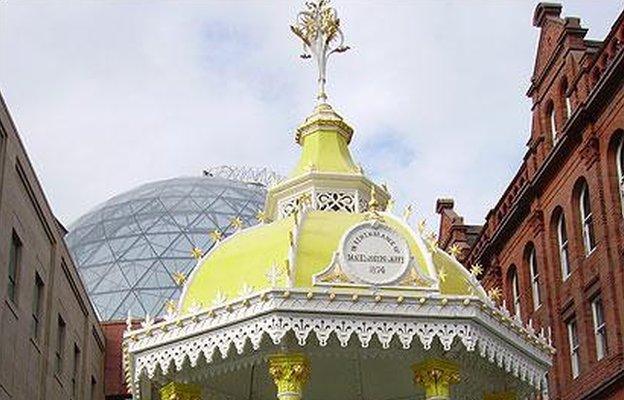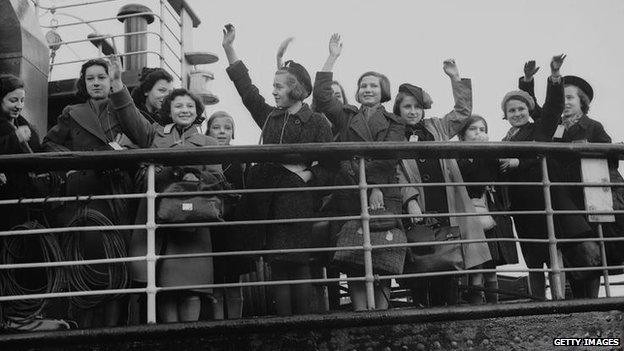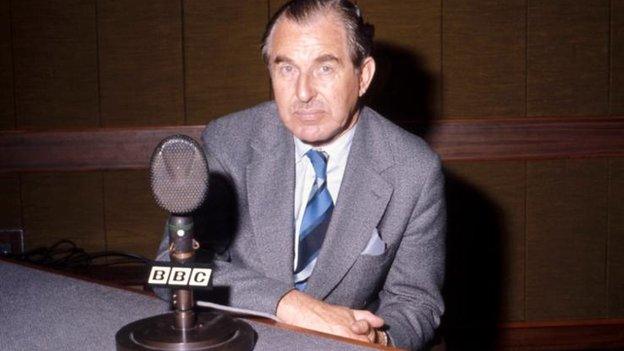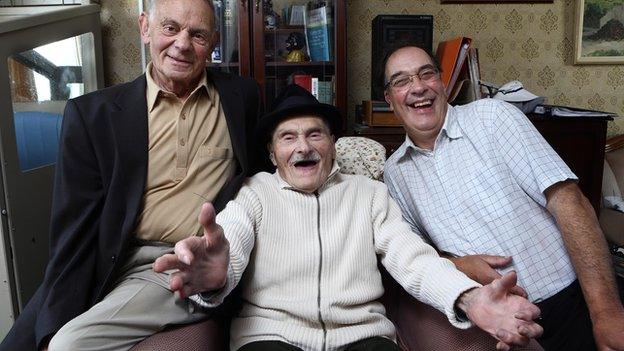150 years of Belfast's Jewish community
- Published

A gathering at the consecration of Somerton Road synagogue in north Belfast in 1964
Jewish community leaders in Belfast have been marking Holocaust Memorial Day.
At its peak, the Belfast Jewish Community had about 1,500 members, but these days, the community's membership has fallen to fewer than 80 people.
The community celebrates its 150th anniversary this year.

Foundation

Daniel Jaffe is commemorated with a fountain that stands beside Victoria Square shopping centre
The Belfast Jewish community was established by German linen merchants, principally the Jaffe family and Eastern European families who were fleeing to escape persecution from the Russian Tsars.
Linen merchant Daniel Jaffe moved to Belfast in 1845, and was behind the first synagogue at Great Victoria Street in the early 1870s. He is commemorated by an ornamental drinking fountain that still stands beside the Victoria Square shopping centre.
The experience of his son Otto, who moved to the city from Hamburg at the age of six, suggests that attitudes to the Jewish community were not always healthy, according to Rabbi David Singer of the Belfast Synagogue.
One of the city's most prominent citizens at the turn of the last century, Sir Otto Jaffe became Lord Mayor of Belfast in 1899 and was the German consul in the city.
Known for his philanthropy, he helped to pay for Belfast's Royal Victoria Hospital and assisted the setting up of the city's first free library.
Although he had denaturalised as a German citizen to become British many years before, at the outbreak of World War One he became the target of suspicion and intimidation, and his family moved to London for good.
Rabbi Singer says: "I'm not sure if he left because he was Jewish and advised to go, or German and advised to go, but the combination of two is eyebrow-raising."

Anti-semitism
Fifty-six years after the liberation of Belsen, former Ulster Unionist leader Lord Molyneaux returned to location of the concentration camp in Germany.
Rabbi David Singer of the Belfast Synagogue says Northern Ireland does not have a history of virulent anti-semitism.
"Certainly in the 1920s and 1930s, for example when you see the rise of the fascist Oswald Mosley in England, there was nothing like that here," he says.
One incident in 1926 when some Jewish children were refused membership of a local tennis club, led to the formation of the Belfast Jewish Institute social club in north Belfast.
Arising out of this, a building was constructed as a focal point for the community, housing four tennis courts, a kosher restaurant, and a ballroom catering for receptions and bar mitzvah celebrations.
"It was a very common attitude around the UK that lots of sports clubs would have membership for anybody apart from Jewish people," says Rabbi Singer, who is from Birmingham.
While the anti-semitism may not have been overt, Rabbi Singer says there are certain things that suggest underlying discriminatory attitudes.
"If you look in the City Cemetery in Belfast, there is an obelisk there on which it's written that this is an area where Jewish people are buried, but it was the policy of the city council that no gravestones were allowed to be put up," he says.
"Up until the 1930s, it would have been unusual to have individual gravestones for Jewish people."

World War Two haven

Child refugees fled Germany in what was known as the Kindertransport
As the Nazis began rounding up Jewish people in the late 1930s, a small group of Jewish children came to live at a farm in Millisle, County Down.
The refugees from Germany, Austria and Czechoslovakia were rescued from their homes after their parents were arrested by the Nazis.
This transportation of children to safe havens in Britain and Ireland was known as the Kindertransport.
The farm, which had space for more than 300 adults and children, was run in a way similar to a kibbutz and would eventually become self sufficient.
"It was a combined effort between the Jewish community in Northern Ireland and England, and the local authorities, extending the welcome and shelter to those youngsters," says Rabbi Singer.

Famous son

Chaim Herzog, pictured in 1976
The most well-known Jewish person born in Belfast is Chaim Herzog, who served as the sixth president of Israel between 1983 and 1993.
While he was born at Clifton Park Avenue in north Belfast in 1918, his family eventually emigrated to Palestine.
He fought in the British Army during World War Two, and went on to hold a number of positions in the newly created state of Israel in 1948, including ambassador to the United Nations. He died in 1993.
Last year, an Ulster History Circle blue plaque erected at his birthplace was removed after it was vandalised with anti-Israeli graffiti.
His father, Dr Isaac Herzog, was appointed chief rabbi of Ireland and later elected as chief rabbi of Israel.
And Chaim Herzog's son Isaac has followed his father into politics, currently serving as the leader of the opposition Labor Party in Israel.
- Published10 March 2014
